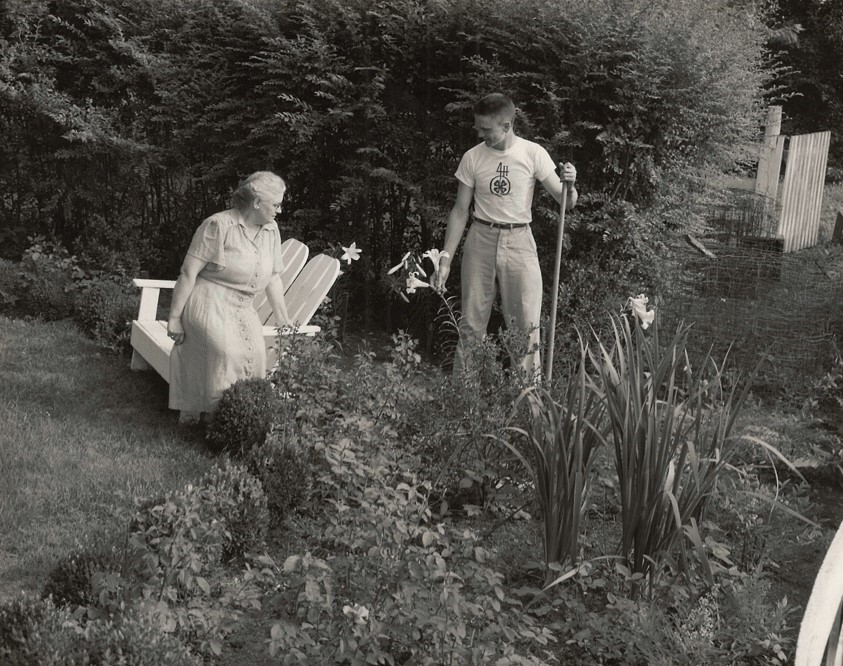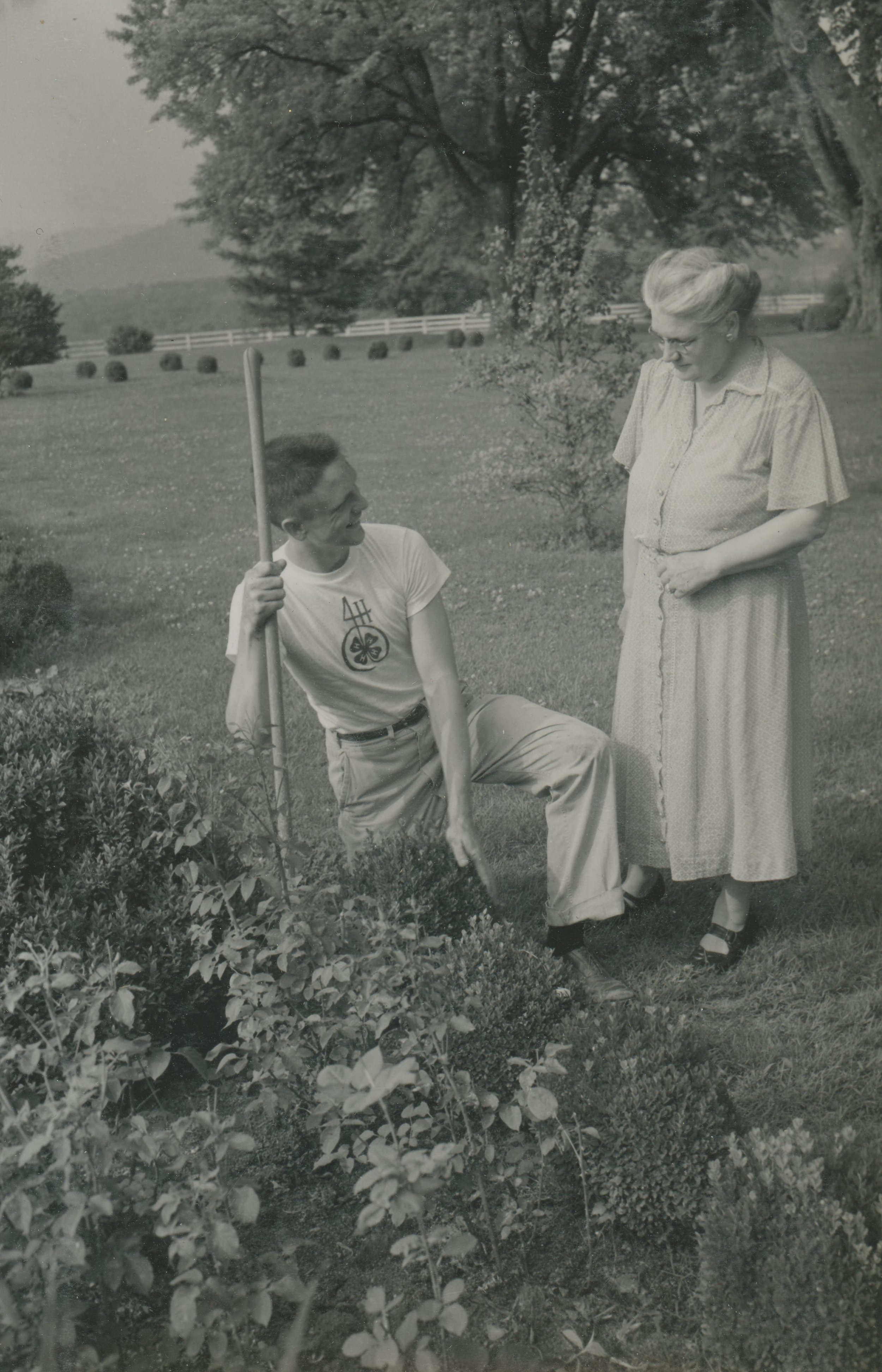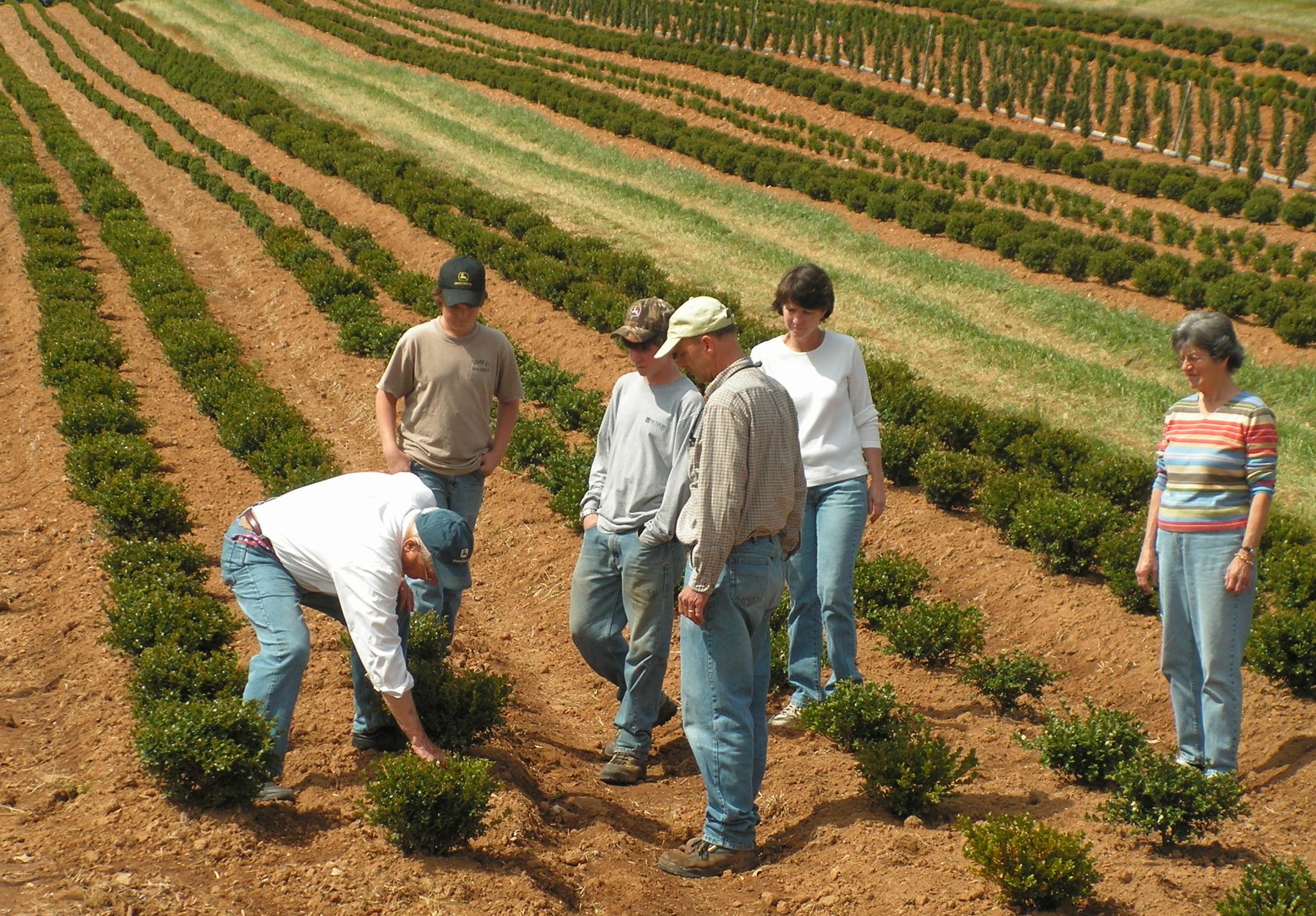Young Paul with his mother Mildred Saunders.
Paul and Mildred looking at some Boxwood in the garden.
On a bright April day in 1947, 13-year-old Paul Saunders joined his mother Mildred as she pruned the English boxwood hedges around the front porch of their home. Even though baseball was Paul’s favorite pastime, he turned down a game with his friends playing in a nearby cow pasture to shadow his mother, an enthusiastic gardener and passionate member of the Nelson County Garden Club. Paul had learned how to propagate shrubs from his science teacher and local nurseryman, Mr. Atto. Paul gathered 77 cuttings as his mother snipped, and planted them in a nearby patch on the northern side of an eroded hill, a perfect spot with a thicket of pines overhead for shade, and a spring close by for water.
Paul enlisted the help of his friend “Boochie” White to become his partner in the venture. Boochie was responsible for most of the watering because he lived close to the plants. Of those 77 cuttings, 25 rooted and became the genesis of the Saunders family’s commercially-grown boxwood nursery.
The boxwood patch next to the hen house.
The following July Paul bought out Boochie’s interest for $1.00 and moved the fledgling nursery to a new location that offered richer soil and a water spigot. Buoyed with the success of the first planting, he then planted 1,000 cuttings of both English and American boxwood. “I could water them daily with a water hose from the spigot at the hen house,” Paul reflected. “My little boxwood nursery became part of my 4-H Home Grounds Beautification project. I stuck more cuttings in rooting beds near an old woodpile. John Whitehead, our County Farm Agent, encouraged me as the nursery grew.” Paul remembers many people asking him, “What are you going to do with all those boxwood?” “I don’t know,” he replied, and went on planting.
A young Robert, John, and Bennett Saunders checking the boxwood cuttings.
A young Tatum working in the nursery.
Year after year, Paul continued to plant more boxwood and as the nursery grew, so did the family. Paul met his wife Tatum in 1955 in Franklin County at a 4-H party. He recalls that on one of their early dates, she helped him strip boxwood cuttings to prepare for planting. They married and eventually welcomed seven sons to their family. The boys (four of whom run the Saunders Brothers nursery today) all have stories of what it was like to grow up on the farm. “If you ate at the dinner table at night, you were expected to be at work the next day at 8 A.M., all days except Sunday,” reflects Bennett Saunders. “No exceptions, even for friends of the family.”
Paul with sons Massie and Tom.
John and Sam Saunders walking through the nursery in the snow.
Plants were first marketed locally, but as the nursery grew, boxwood began to be shipped all over Virginia. One day in 1962, Paul received a phone call from the National Park Service, asking to buy 1,500 boxwood. Paul asked where the plants were going, but he was told their destination was confidential. Eventually the word got out that the boxwood were headed to the White House. President John F. Kennedy and his wife Jacqueline had recently returned from an international trip where they were inspired by the formal European gardens, and wanted to renovate the White House Rose Garden. The 1,500 boxwood used in the renovation can still be seen from the windows of the Oval Office today.
Boxwood being loaded to go to The White House
Saunders Boxwood being planted in the Rose Garden
The nursery continued to expand to the farm’s fertile river bottoms and hillsides. All was well and sights were set on a bright future until a warm August night in 1969 when Mother Nature threw a monkey wrench in the plan. In less than five hours, through the middle of the night, Hurricane Camille dumped over 20 inches of rain on the mountains of Nelson County, Virginia. The devastation and loss of life in the county were horrendous (1% of the population perished). Mudslides, flooding, and avalanches of debris covered the area. The raging Tye River destroyed nearly 10 acres of Saunders plants and land. Although the damage was devastating, a few boxwood that were planted on higher ground, survived. This nucleus gave birth to a container nursery at Tye Brook Farm.
Paul walking through a crop of boxwood.
In the late 60s and 70s boxwood were moved down to the packing shed in peach bins, where they were then loaded on to trucks.
Although boxwood had been used as a common landscape plant for many years, only two varieties, English and American, were commonly used in landscapes. That changed in the 1970s as boxwood came to face more and more disease problems. As a result, Paul proceeded to look at different varieties for a solution. “We began to see these problems and started searching for other strains that we could substitute. I talked to people all over the boxwood-growing areas, asking their advice as to their choices of the best varieties,” recalled Paul. “There was no real consensus; what was doing well in one area was not necessarily doing well in another area. In order to find out which variety was best suited in a particular area, we established evaluation sites from Connecticut to Chicago, south to Alabama and Georgia, and many areas in between, donating thousands of boxwood to the sites to get the project started.” Working with many public and private gardens, universities, and researchers, the National Boxwood Trials were born. Over 60 participants reported their observations of a variety of cultivars in two basic categories, plant attractiveness and grower friendliness. The results were published annually, with the final report being published in 2011. Paul describes the Boxwood Trials as one of his proudest accomplishments.
Three generations in the field learning about boxwood. Paul and his grandsons, Tye and Marshall, are joined by their father Bennett, his wife Lynn and Paul’s wife Tatum.
From one 13 year-old boy’s love of a charming little evergreen, grew a family business dedicated to innovation. The Saunders family continues to do research through Saunders Genetics, LLC. to find the best boxwood to flourish in each of a wide diversity of micro-environments.
Paul with one of his favorite boxwood cultivars.













